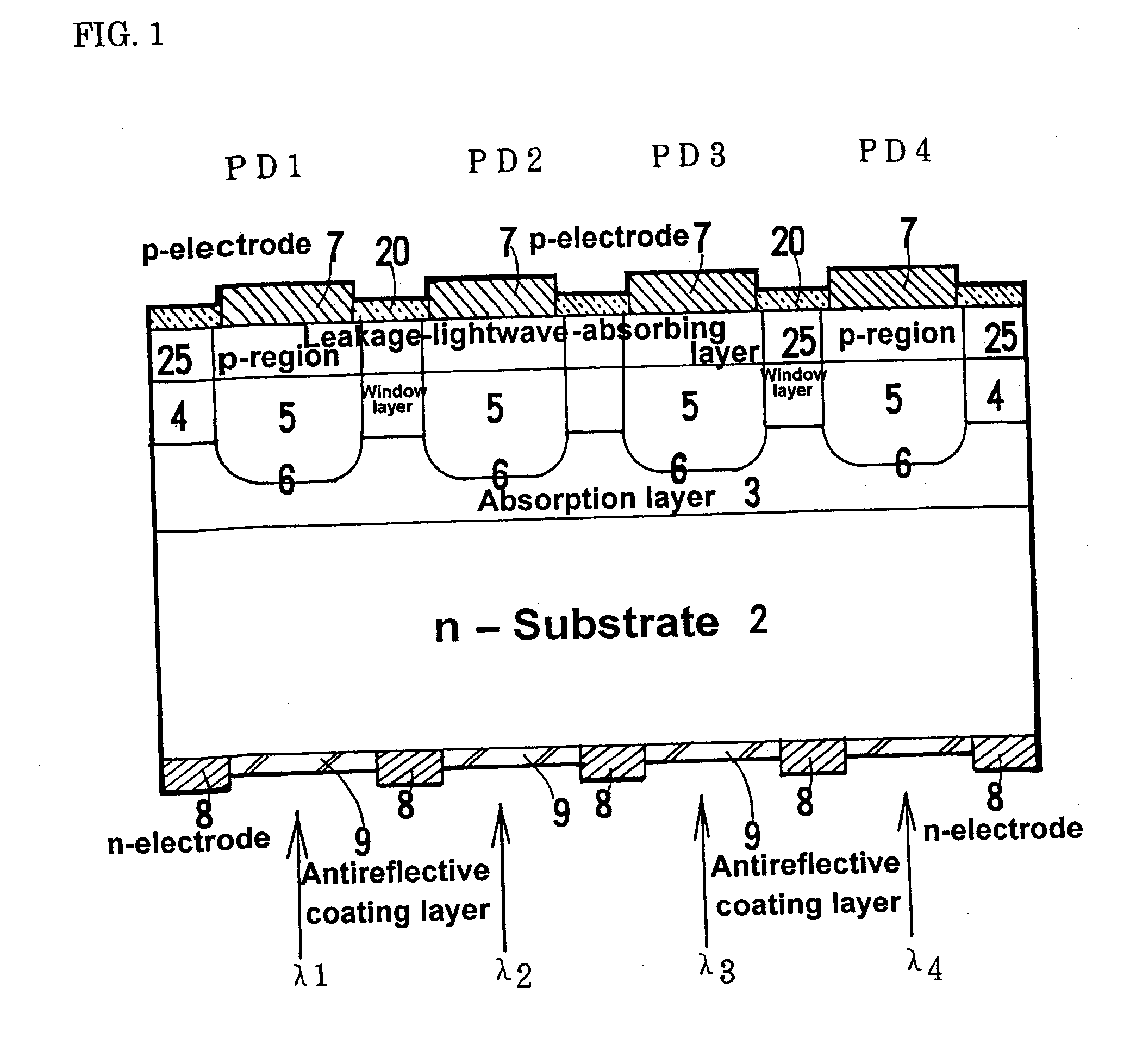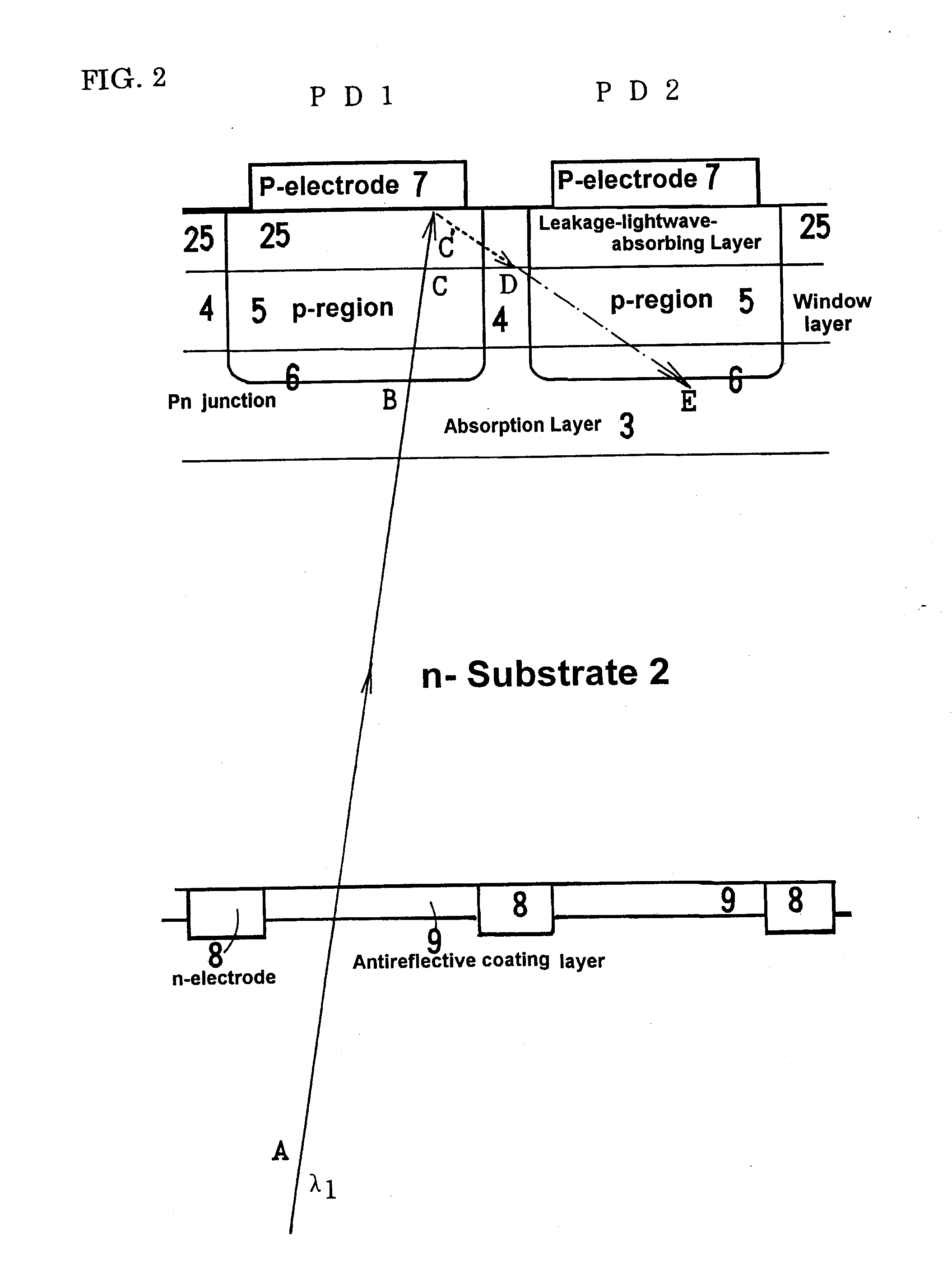Rear-Illuminated -Type Photodiode Array
a photodiode array and rear illumination technology, applied in the field of rear illumination type photodiode array, can solve the problems of electrical crosstalk, difficult to reduce the pitch to such a small value, and not all of the incoming lightwave is absorbed in the absorption layer, so as to prevent optical crosstalk
- Summary
- Abstract
- Description
- Claims
- Application Information
AI Technical Summary
Benefits of technology
Problems solved by technology
Method used
Image
Examples
example 1
One-Dimensionally Arranged Photodiode Array (M×1: FIG. 3)
[0060] The method of producing a rear-illuminated-type photodiode array of the present invention shown in FIG. 3 is explained below. The following layers were epitaxially grown by the metalorganic vapor phase epitaxial method (MOVPE method) in the following order on an n-type InP substrate 2 that had a thickness of 350 μm, that was doped with sulfur, and that had a carrier concentration of n=3×1018 cm−3: [0061] an n-type InP buffer layer 30 (thickness: 2 μm, undoped, and carrier concentration: n=1×1015 cm−3); [0062] an n-type InGaAs absorption layer 3 (thickness: 4 μm, undoped, carrier concentration: n=1×1015 cm−3, and lattice-matched with the InP); [0063] an n-type InP window layer 4 (thickness: 1.5 μm, undoped, and carrier concentration: n=1×1015 cm−3); and [0064] an n-type InGaAs leakage-lightwave-absorbing layer 25 (thickness: 3 μm, undoped, and carrier concentration: n=1×1015 cm−3).
[0065] Triethylgallium (TEG), trimethy...
example 2
Two-Dimensionally Arranged Photodiode Array (M×N: FIGS. 4 and 5)
[0070] The present invention can also be applied to a rear-illuminated-type two-dimensionally arranged photodiode array. FIG. 4 shows a partial plan view of it, and FIG. 5 shows a partial cross-sectional view of it. This array is formed by arranging photodiode units, “M×N” in number, on one chip. When viewed from above, a p-region 5, a p-electrode 7, and a bump 40 are concentrically placed to form a unit and a multitude of units are arranged in rows and columns like “islands” in a “sea” of the leakage-lightwave-absorbing layer 25. Actually, the top surface is covered with an antireflective coating and the p-electrodes 7 complementarily. The bumps 40 are made of a low-melting-point alloy formed by vapor deposition, plating, or printing and are to be used for soldering. They are provided to flip-chip-connect the array with an IC chip (such as one having amplifying circuits) provided with electrodes placed with the same t...
example 3
A Photodiode Array Having an N-Electrode Placed on a Substrate or Buffer Layer (FIG. 6)
[0073] Examples 1 and 2 show an array in which an n-electrode is provided at the rear side of the substrate. The present invention can also be applied to a photodiode array in which an n-electrode is provided on a portion of a substrate or buffer layer that is exposed by etching a part of the layers epitaxially grown on the substrate. FIG. 6 shows a partial cross-sectional view of the photodiode array. In this case, the photodiode units may be arranged one- or two-dimensionally. The photodiode array is provided with a buffer layer 30, an absorption layer 3, a window layer 4, and a leakage-lightwave-absorbing layer 25 all grown epitaxially on the n-type substrate. Individual p-electrodes 7 are provided on individual p-regions 5. Part of the leakage-lightwave-absorbing layer 25, the window layer 4, and the absorption layer 3 are removed by etching. An n-electrode 8 is placed on the exposed portion ...
PUM
 Login to View More
Login to View More Abstract
Description
Claims
Application Information
 Login to View More
Login to View More - R&D
- Intellectual Property
- Life Sciences
- Materials
- Tech Scout
- Unparalleled Data Quality
- Higher Quality Content
- 60% Fewer Hallucinations
Browse by: Latest US Patents, China's latest patents, Technical Efficacy Thesaurus, Application Domain, Technology Topic, Popular Technical Reports.
© 2025 PatSnap. All rights reserved.Legal|Privacy policy|Modern Slavery Act Transparency Statement|Sitemap|About US| Contact US: help@patsnap.com



